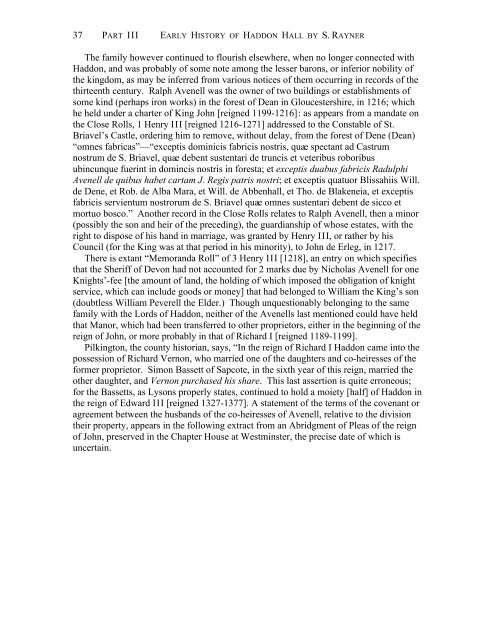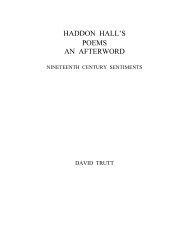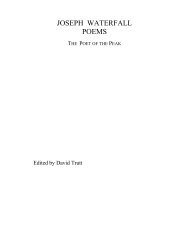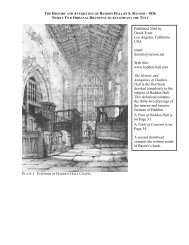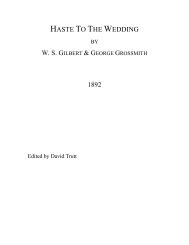Download - Haddon Hall
Download - Haddon Hall
Download - Haddon Hall
You also want an ePaper? Increase the reach of your titles
YUMPU automatically turns print PDFs into web optimized ePapers that Google loves.
37 PART III EARLY HISTORY OF HADDON HALL BY S. RAYNER<br />
The family however continued to flourish elsewhere, when no longer connected with<br />
<strong>Haddon</strong>, and was probably of some note among the lesser barons, or inferior nobility of<br />
the kingdom, as may be inferred from various notices of them occurring in records of the<br />
thirteenth century. Ralph Avenell was the owner of two buildings or establishments of<br />
some kind (perhaps iron works) in the forest of Dean in Gloucestershire, in 1216; which<br />
he held under a charter of King John [reigned 1199-1216]: as appears from a mandate on<br />
the Close Rolls, 1 Henry III [reigned 1216-1271] addressed to the Constable of St.<br />
Briavel’s Castle, ordering him to remove, without delay, from the forest of Dene (Dean)<br />
“omnes fabricas”—“exceptis dominicis fabricis nostris, quae spectant ad Castrum<br />
nostrum de S. Briavel, quae debent sustentari de truncis et veteribus roboribus<br />
ubincunque fuerint in domincis nostris in foresta; et exceptis duabus fabricis Radulphi<br />
Avenell de quibus habet cartam J. Regis patris nostri; et exceptis quatuor Blissahiis Will.<br />
de Dene, et Rob. de Alba Mara, et Will. de Abbenhall, et Tho. de Blakeneia, et exceptis<br />
fabricis servientum nostrorum de S. Briavel quae omnes sustentari debent de sicco et<br />
mortuo bosco.” Another record in the Close Rolls relates to Ralph Avenell, then a minor<br />
(possibly the son and heir of the preceding), the guardianship of whose estates, with the<br />
right to dispose of his hand in marriage, was granted by Henry III, or rather by his<br />
Council (for the King was at that period in his minority), to John de Erleg, in 1217.<br />
There is extant “Memoranda Roll” of 3 Henry III [1218], an entry on which specifies<br />
that the Sheriff of Devon had not accounted for 2 marks due by Nicholas Avenell for one<br />
Knights’-fee [the amount of land, the holding of which imposed the obligation of knight<br />
service, which can include goods or money] that had belonged to William the King’s son<br />
(doubtless William Peverell the Elder.) Though unquestionably belonging to the same<br />
family with the Lords of <strong>Haddon</strong>, neither of the Avenells last mentioned could have held<br />
that Manor, which had been transferred to other proprietors, either in the beginning of the<br />
reign of John, or more probably in that of Richard I [reigned 1189-1199].<br />
Pilkington, the county historian, says, “In the reign of Richard I <strong>Haddon</strong> came into the<br />
possession of Richard Vernon, who married one of the daughters and co-heiresses of the<br />
former proprietor. Simon Bassett of Sapcote, in the sixth year of this reign, married the<br />
other daughter, and Vernon purchased his share. This last assertion is quite erroneous;<br />
for the Bassetts, as Lysons properly states, continued to hold a moiety [half] of <strong>Haddon</strong> in<br />
the reign of Edward III [reigned 1327-1377]. A statement of the terms of the covenant or<br />
agreement between the husbands of the co-heiresses of Avenell, relative to the division<br />
their property, appears in the following extract from an Abridgment of Pleas of the reign<br />
of John, preserved in the Chapter House at Westminster, the precise date of which is<br />
uncertain.


